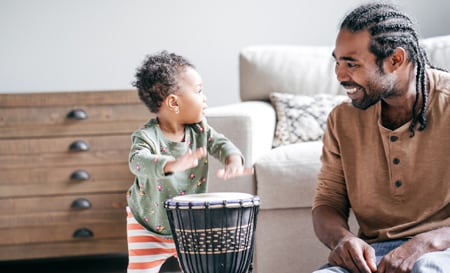Praise, Imitation, and Description

Praise
Praise happens when you give positive attention to your child for good behavior.
Why is Praise a good tool to use?
Praise lets your child know what behaviors you like. When you praise behaviors you like, your child will do those behaviors more often. Praise can also help your child feel good about herself.
What type of Praise works best?
Specific praise works best because your child knows exactly what you like. This type of praise is called labeled praise. Unlabeled praise is a general statement that shows approval or affection. Unlabeled praise can help children feel good but does not help improve behavior. It doesn’t let your child know exactly what is liked.
Examples
- Great Job!
- Super!
- Way to go!
- What a great job of putting your toys away!
- You did a super job making your bed!
- Way to go sharing with your brother!
Imitation
You imitate your child’s behavior when you copy or mimic what she is doing. This means that you play with the same or a similar toy and attempt to use the toy like your child is using it.
Why is Imitation a good tool to use?
Any behavior you imitate is likely to be repeated by your child. When you imitate your child’s play, you show her you are paying attention and like what she is doing. Imitation can help a child feel good about herself and gives you a lot of chances to give positive attention.
Description
Descriptions occur when you talk about what your child is doing in as much detail as possible. You describe what your child is doing like a sports reporter might describe what is going on to someone who can’t see the action.
Why is Description a good tool to use?
Descriptions show your child you are interested in what he is doing and you are giving him your full attention. In this way, descriptions can help build self-esteem because it lets your child know you think what he is doing is interesting. Descriptions are also helpful in holding your child’s attention. This helps increase the length of time your child is able to stick to the task, which prepares your child for the focus he needs when he begins school.
Descriptions can encourage language development because your descriptions give your child words to describe something, which helps build vocabulary and they can help you teach your child. For example, you can teach your child how to count, or name colors by using descriptions.
Example
“You’re looking at all the pieces and trying to decide which one you want. Oh, you decided to put a green cowboy hat on the potato. Nice job getting the hat on. Now he has a mustache. You picked the green glasses that match the green hat. Those glasses are tough to put on, and I like how hard you are trying. I am glad you stuck with it and you got those glasses on his face.”
Check out Quick Tips and Answers from Experts for more info about special playtime!
Click through the links below to watch videos and practice your skills for communicating with your child.
Watch Videos
Practice Skills